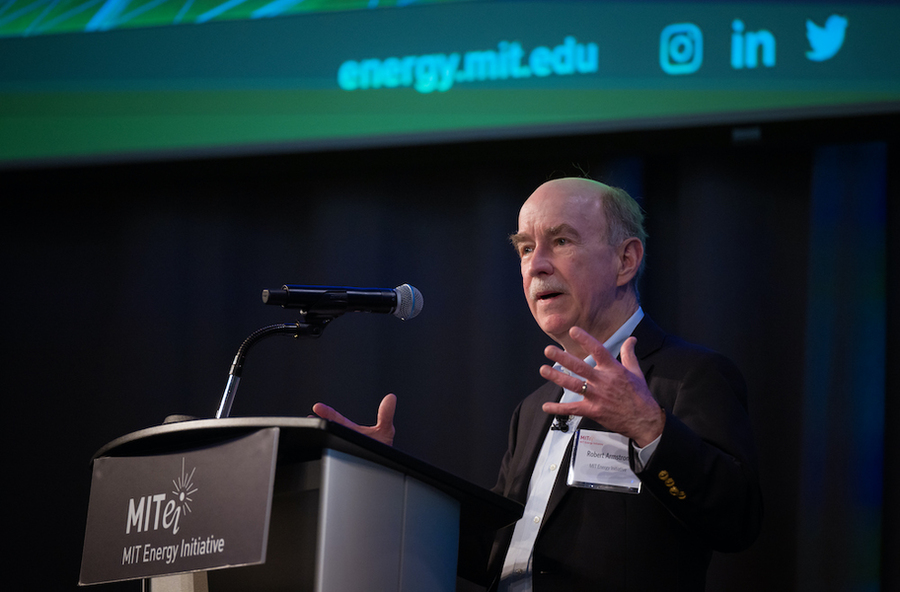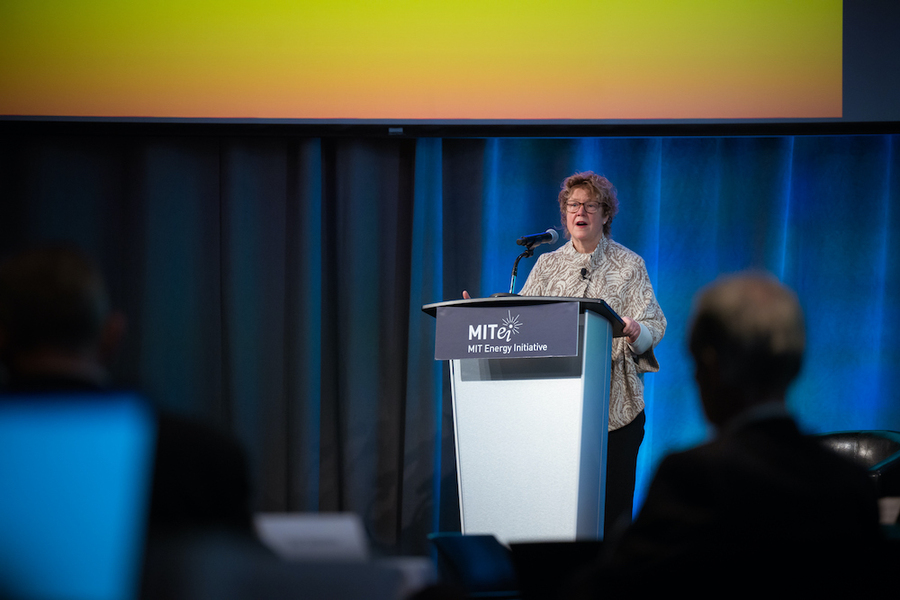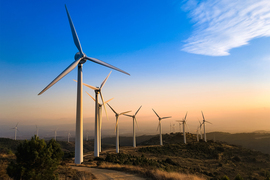Capturing energy from the winds gusting off the coasts of the United States could more than double the nation’s electricity generation. It’s no wonder the Biden administration views this immense, clean-energy resource as central to its ambitious climate goals of 100 percent carbon-emissions-free electricity by 2035 and a net-zero emissions economy by 2050. The White House is aiming for 30 gigawatts of offshore wind by 2030 — enough to power 10 million homes.
At the MIT Energy Initiative’s Spring Symposium, academic experts, energy analysts, wind developers, government officials, and utility representatives explored the immense opportunities and formidable challenges of tapping this titanic resource, both in the United States and elsewhere in the world.
“There’s a lot of work to do to figure out how to use this resource economically — and sooner rather than later,” said Robert C. Armstrong, MITEI director and the Chevron Professor of Chemical Engineering, in his introduction to the event.
In sessions devoted to technology, deployment and integration, policy, and regulation, participants framed the issues critical to the development of offshore wind, described threats to its rapid rollout, and offered potential paths for breaking through gridlock.
R&D advances
Moderating a panel on MIT research that is moving the industry forward, Robert Stoner, MITEI’s deputy director for science and technology, provided context for the audience about the industry.
“We have a high degree of geographic coincidence between where that wind capacity is and where most of us are, and it’s complementary to solar,” he said. Turbines sited in deeper, offshore waters gain the advantage of higher-velocity winds. “You can make these machines huge, creating substantial economies of scale,” said Stoner. An onshore turbine generates approximately 3 megawatts; offshore structures can each produce 15 to 17 megawatts, with blades the length of a football field and heights greater than the Washington Monument.
To harness the power of wind farms spread over hundreds of nautical miles in deep water, Stoner said, researchers must first address some serious issues, including building and maintaining these massive rigs in harsh environments, laying out wind farms to optimize generation, and creating reliable and socially acceptable connections to the onshore grid. MIT scientists described how they are tackling a number of these problems.
“When you design a floating structure, you have to prepare for the worst possible conditions,” said Paul Sclavounos, a professor of mechanical engineering and naval architecture who is developing turbines that can withstand severe storms that batter turbine blades and towers with thousands of tons of wind force. Sclavounos described systems used in the oil industry for tethering giant, buoyant rigs to the ocean floor that could be adapted for wind platforms. Relatively inexpensive components such as polyester mooring lines and composite materials “can mitigate the impact of high waves and big, big wind loads.”
To extract the maximum power from individual turbines, developers must take into account the aerodynamics among turbines in a single wind farm and between adjacent wind farms, according to Michael Howland, the Esther and Harold E. Edgerton Assistant Professor of Civil and Environmental Engineering. Howland’s work modeling turbulence in the atmosphere and wind speeds has demonstrated that angling turbines by just a small amount relative to each other can increase power production significantly for offshore installations, dramatically improving their efficiencies. Howland hopes his research will promote “changing the design of wind farms from the beginning of the process.”
There’s a staggering complexity to integrating electricity from offshore wind into regional grids such as the one operated by ISO New England, whether converting voltages or monitoring utility load. Steven B. Leeb, a professor of electrical engineering and computer science and of mechanical engineering, is developing sensors that can indicate electronic failures in a micro grid connected to a wind farm. And Marija Ilić, a joint adjunct professor in the Department of Electrical Engineering and Computer Science and a senior research scientist at the Laboratory for Information and Decision Systems, is developing software that would enable real-time scheduling of controllable equipment to compensate for the variable power generated by wind and other variable renewable resources. She is also working on adaptive distributed automation of this equipment to ensure a stable electric power grid.
“How do we get from here to there?”
Symposium speakers provided snapshots of the emerging offshore industry, sharing their sense of urgency as well as some frustrations.
Climate poses “an existential crisis” that calls for “a massive war-footing undertaking,” said Melissa Hoffer, who occupies the newly created cabinet position of climate chief for the Commonwealth of Massachusetts. She views wind power “as the backbone of electric sector decarbonization.” With the Vineyard Wind project, the state will be one of the first in the nation to add offshore wind to the grid. “We are actually going to see the first 400 megawatts … likely interconnected and coming online by the end of this year, which is a fantastic milestone for us,” said Hoffer.
The journey to completing Vineyard Wind involved a plethora of painstaking environmental reviews, lawsuits over lease siting, negotiations over the price of the electricity it will produce, buy-in from towns where its underground cable comes ashore, and travels to an Eversource substation. It’s a familiar story to Alla Weinstein, founder and CEO of Trident Winds, Inc. On the West Coast, where deep waters (greater than 60 meters) begin closer to shore, Weinstein is trying to launch floating offshore wind projects. “I’ve been in marine renewables for 20 years, and when people ask why I do what I do, I tell them it’s because it matters,” she said. “Because if we don’t do it, we may not have a planet that’s suitable for humans.”
Weinstein’s “picture of reality” describes a multiyear process during which Trident Winds must address the concerns of such stakeholders as tribal communities and the fishing industry and ensure compliance with, among other regulations, the Marine Mammal Protection Act and the Migratory Bird Species Act. Construction of these massive floating platforms, when it finally happens, will require as-yet unbuilt specialized port infrastructure and boats, and a large skilled labor force for assembly and transmission. “This is a once-in-a-lifetime opportunity to create a new industry,” she said, but “how do we get from here to there?”
Danielle Jensen, technical manager for Shell’s Offshore Wind Americas, is working on a project off of Rhode Island. The blueprint calls for high-voltage, direct-current cable snaking to landfall in Massachusetts, where direct-current lines switch to alternating current to connect to the grid. “None of this exists, so we have to find a space, the lands, and the right types of cables, tie into the interconnection point, and work with interconnection operators to do that safely and reliably,” she said.
Utilities are partnering with developers to begin clearing some of these obstacles. Julia Bovey, director of offshore wind for Eversource, described her firm’s redevelopment or improvement of five ports, and new transport vessels for offshore assembly of wind farm components in Atlantic waters. The utility is also digging under roads to lay cables for new power lines. Bovey notes that snags in supply chains and inflation have been driving up costs. This makes determining future electricity rates more complex, especially since utility contracts and markets work differently in each state.
Just seven up
Other nations hold a commanding lead in offshore wind: To date, the United States claims just seven operating turbines, while Denmark boasts 6,200 and the U.K. 2,600. Europe’s combined offshore power capacity stands at 30 gigawatts — which, as MITEI Research Scientist Tim Schittekatte notes, is the U.S. goal for 2030.
The European Union wants 400 gigawatts of offshore wind by 2050, a target made all the more urgent by threats to Europe’s energy security from the war in Ukraine. “The idea is to connect all those windmills, creating a mesh offshore grid,” Schittekatte said, aided by E.U. regulations that establish “a harmonized process to build cross-border infrastructure.”
Morten Pindstrup, the international chief engineer at Energinet, Denmark’s state-owned energy enterprise, described one component of this pan-European plan: a hybrid Danish-German offshore wind network. Energinet is also constructing energy islands in the North Sea and the Baltic to pool power from offshore wind farms and feed power to different countries.
The European wind industry benefits from centralized planning, regulation, and markets, said Johannes P. Pfeifenberger, a principal of The Brattle Group. “The grid planning process in the U.S. is not suitable today to find cost-effective solutions to get us to a clean energy grid in time,” he said. Pfeifenberger recommended that the United States immediately pursue a series of moves including a multistate agreement for cooperating on offshore wind and establishment by grid operators of compatible transmission technologies.
Symposium speakers expressed sharp concerns that complicated and prolonged approvals, as well as partisan politics, could hobble the nation’s nascent offshore industry. “You can develop whatever you want and agree on what you’re doing, and then the people in charge change, and everything falls apart,” said Weinstein. “We can’t slow down, and we actually need to accelerate.”
Larry Susskind, the Ford Professor of Urban and Environmental Planning, had ideas for breaking through permitting and political gridlock. A negotiations expert, he suggested convening confidential meetings for stakeholders with competing interests for collaborative problem-solving sessions. He announced the creation of a Renewable Energy Facility Siting Clinic at MIT. “We get people to agree that there is a problem, and to accept that without a solution, the system won’t work in the future, and we have to start fixing it now.”
Other symposium participants were more sanguine about the success of offshore wind. “Trust me, floating wind is not a pie-in-the-sky, exotic technology that is difficult to implement,” said Sclavounos. “There will be companies investing in this technology because it produces huge amounts of energy, and even though the process may not be streamlined, the economics will work itself out.”














